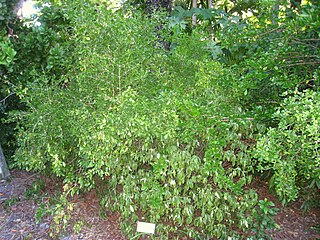
The Rubiaceae are a family of flowering plants, commonly known as the coffee, madder, or bedstraw family. It consists of terrestrial trees, shrubs, lianas, or herbs that are recognizable by simple, opposite leaves with interpetiolar stipules and sympetalous actinomorphic flowers. The family contains about 13,500 species in about 620 genera, which makes it the fourth-largest angiosperm family. Rubiaceae has a cosmopolitan distribution; however, the largest species diversity is concentrated in the tropics and subtropics. Economically important genera include Coffea, the source of coffee, Cinchona, the source of the antimalarial alkaloid quinine, ornamental cultivars, and historically some dye plants.

Psychotria carthagenensis, also known as amyruca, is a South American rainforest understory shrub from the coffee family, Rubiaceae. It grows from the tropics of South America to Mexico.

Psychotria is a genus of flowering plants in the family Rubiaceae. It contains 1,582 species and is therefore one of the largest genera of flowering plants. The genus has a pantropical distribution and members of the genus are small understorey trees in tropical forests. Some species are endangered or facing extinction due to deforestation, especially species of central Africa and the Pacific.

Palicourea is a plant genus in the family Rubiaceae. It contains about 200 species, which range from shrubs to small trees, and is distributed throughout the New World tropics.
Psychotria adamsonii is a species of plant in the family Rubiaceae. It is a shrub or tree endemic to the island of Ua Pou in the Marquesas Islands of French Polynesia. It is thought to be extinct.
Psychotria beddomei is a species of plant in the family Rubiaceae. It is endemic to Kerala in India.
Psychotria crassipetala is a species of plant in the family Rubiaceae. This species was firstly described by E. Petit in 1964 and believed endemic to Kenya for a long time, but recently found also in Tanzania.
Psychotria dura is a species of flowering plant in the family Rubiaceae. It is endemic to Jamaica.
Psychotria globicephala is a species of plant in the family Rubiaceae. It is native to Kerala and Tamil Nadu in India.
Psychotria grantii is a species of plant in the family Rubiaceae. It is a shrub or tree endemic to the island of Tahiti in the Society Islands of French Polynesia.
Psychotria speciosa is a species of plant in the family Rubiaceae. It is a shrub or tree endemic to the island of Tahiti in the Society Islands of French Polynesia.
Psychotria rufipilis is an African rainforest understory shrub from the coffee family, Rubiaceae.

Psychotridine is an alkaloid found in some species of the genus Psychotria, namely Psychotria colorata, but also Psychotria forsteriana, Psychotria lyciiflora, Psychotria oleoides, and Psychotria beccarioides. Psychotridine has analgesic effects and dose-dependently inhibits dizocilpine binding to cortical membranes in vitro, suggesting that it acts as a non-competitive NMDA receptor antagonist.

Psychotria ligustrifolia, the Bahama wild coffee, is a species of plant in the family Rubiaceae. It is native to Florida, Puerto Rico, and the Bahamas.
Candidatus Caballeronia kirkii is a Gram-negative, non-fermenting bacterium from the genus Caballeronia and the family Burkholderiaceae. Ca. C. kirkii is an endosymbiont of the plant Psychotria kirkii, also known as Rubiaceae, and exists inside leaf and stem nodules.

Psychotrieae is a tribe of flowering plants in the family Rubiaceae and contains about 2114 species in 17 genera. Its representatives are found in the tropics and subtropics. Several genera are Myrmecophytes

Dr. Charlotte M. Taylor is a botanist and professor specialising in taxonomy and conservation. She works with the large plant family Rubiaceae, particularly found in the American tropics and in the tribes Palicoureeae and Psychotrieae. This plant family is an economically important group, as it includes plant species used to make coffee and quinine. Taylor also conducts work related to the floristics of Rubiaceae and morphological radiations of the group. Taylor has collected plant samples from many countries across the globe, including Chile, Colombia, Costa Rica, Panama, and the United States of America, and has named many new species known to science from these regions. As of 2015, Taylor has authored 278 land plant species' names, the seventh-highest number of such names authored by any female scientist.

Psychotria tenuifolia, commonly known as velvet-leaved wild coffee, is a species of plant in the family Rubiaceae. It is endemic to southern Florida, South America and the Caribbean. The description of velvet is based on the silky appearance that the leaves display in relation to other species of the same plant family.
Psychotria samoritourei is a liana species belonging to the family Rubiaceae, native to the forests of the Loma-Man highlands in Upper Guinea, West Africa. It is the sixth known lianescent African species of its genus. It is found in Guinea, Liberia and Sierra Leone. It is also possible that the species is present in other, less thoroughly surveyed areas of the submontane forests of the Loma-Man highlands. If discovered, it is likely that the threat status of the species would be reduced. It is a climber to at least 10 m, and possibly up to 20 m.

Psychotria serpens, the creeping psychotria, is a species of flowering plant in the family Rubiaceae, native to Peninsula Malaysia, Southeast Asia, southeastern China, Hainan, Taiwan, the Ryukyu Islands, and central and southern Japan. A creeping or climbing perennial liana, it is typically found in thickets and forests, from 100 to 1,400 m above sea level. It is often substituted for "Caulis Trachelospermi" in traditional Chinese medicine preparations sold to people with cancer.








